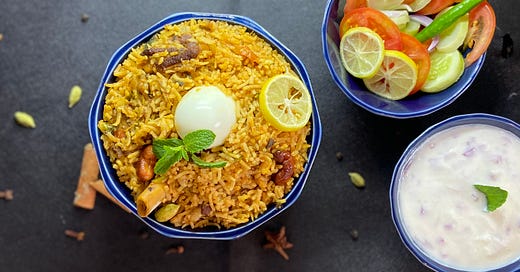Food has a culture. It has a history. It has a story. It has relationships.
– Winona LaDuke
The origin of the word Biryani is a bit hazy; most food historians agree that it either originated from birinj the Persian word for rice or derived from biryan or beriyan, which means "to fry" or "to roast". Similarly, the origin of Biryani also leads to heated debates among the food historians, some believe that biryani originated from Persia and was brought to India by the Mughals and used as a war time food (it is a single pot meal that can be made in large quantities and preserved for days- making it an ideal war campaign food), the Mughals developed it in their royal kitchens and made it a food for the Kings. Another theory is that the Biryani was brought by the Arab traders who arrived as merchants to the Malabar coastal region of South West India, there are references to a rice and meat dish known as ‘Oon Soru’ (oon is meat and Soru means cooked rice) in Tamil literature as early as the year 2 CE. For most of us; this is still a special food, one that is made during weddings and other once in a life time events of the family; or when you, have those special guests for dinner.
Whatever the origin; like many aspects of the Indian culture; the Biryani has been adopted and has become native. Today, it’s not an exaggeration to call it the National dish of India; it is after all the most ordered dish on the food delivery platforms – Swiggy, one such platform, reported that a total of 60,444,000 biryanis were ordered in 2021 through their app (that’s a staggering 115 biryanis delivered/minute on one single platform). When we travel across India, we find many varieties of biryanis, the taste and style could vary every 100 kms; as the spice and even the variety of rice keeps changing across the regions of this vast land.
The magic of Biryani is in the way, the already fragrant rice, fluffs up with the juices from the meat and the spices as they are cooked together. Traditionally Biryani is cooked over a wood fire in two different styles; Kachi Biryani is made by cooking rice along with the meat and spices. Pakki Biryani is made by partially cooking the meat (in the spices) and rice separately and alternately layered and finished in a sealed vessel over a bed of hot coals.
The biryani is further defined by the meat that is used to flavour it; for the purists; it is always the mutton (goat meat – preferably, the tender cuts of a goat’s shoulder); but chicken and fish or prawns are a welcome change. A veg biryani is always frowned upon by these purists 😊; but necessary to satiate the needs of the large vegetarian population of the country.
Rice is the heart of the Biryani; the aged, long-grained basmati is a favourite in the North and the smaller jeeragasamba or kaima varieties are popular in the southern states of the subcontinent. I know of certain chefs, who refuse to make the Biryani if a particular brand of rice is unavailable!
Cooking is not a craft but an art, one that is driven by the instincts and a sense of flavor of the cook, hence there are no strict rules in the making of a biryani; but the basic principle is to keep it simple and not overpower the biryani with the spices. Spice is just the supporting actor in the biryani story; it adds to the flavor and aroma of the meat and rice.
Some other guidelines are: 1. the meat and veggies need to be fresh; the rice needs to be of a fragrant variety. 2. The meat needs to be marinated (in the spices and yogurt) at least for 30 minutes and rice needs to be soaked in water for at least 15 minutes. 3. A part of the finely sliced onions used is fried till they are brown; this adds to the flavor and color of the biryani. Care should be taken that it is not burnt as it will turn bitter 4. Ghee is used generously! 5. Coriander and mint are essential to finish. 6. Depending on the region, there are many accompaniments to the Biryani, but usually an onion raitha (yogurt+ chopped onion+ salt) is sufficient; the coolness of the raitha goes well with the spice of the Biryani. 7. Whether it is pakki or kachi biryani, the finishing process of dum (slow cooking in a sealed vessel) is essential.
When you finish making the biryani; serve it hot and steaming. The aroma of the Biryani, is sure to envelop your home and your guests.
Here are the recipes links to the different versions of Biryani from My Cookbook-





